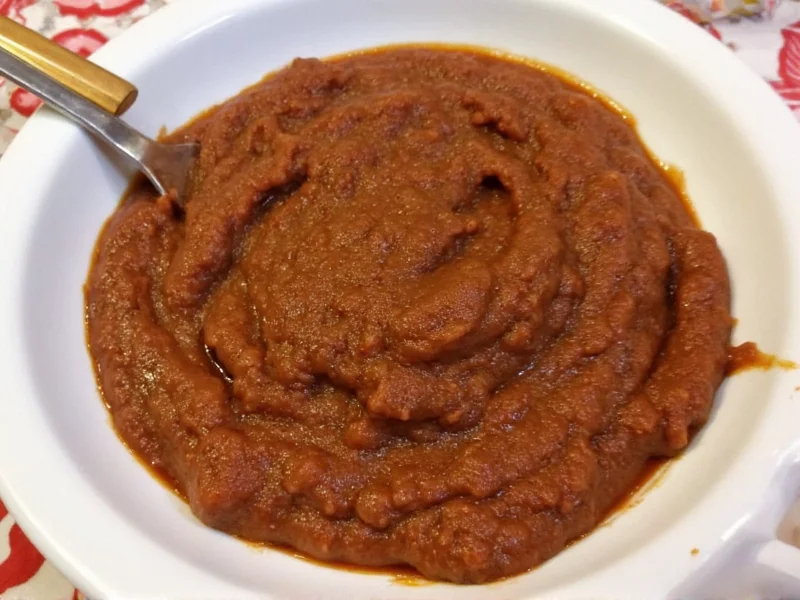Creating authentic ancho paste from scratch transforms your Mexican and Southwestern dishes with deep, complex flavors that pre-made versions simply can't match. As a culinary professional with decades of experience working with Latin American ingredients, I've perfected this straightforward method that balances the ancho chile's natural sweetness with subtle heat and earthy notes.
What Exactly Is Ancho Paste?
Ancho paste comes from dried poblano peppers that have been rehydrated and pureed into a smooth consistency. These " anchos " (meaning "wide" in Spanish) offer a distinctive flavor profile: mildly spicy (1,000-2,000 SHU), with notes of dried fruit, coffee, and subtle tobacco. Unlike ancho powder, which is simply ground dried chiles, authentic ancho paste includes additional ingredients that enhance both preservation and flavor complexity.
Why Homemade Beats Store-Bought
Commercial ancho pastes often contain preservatives, fillers, and inconsistent chile quality. When you make your own ancho chile paste recipe at home, you control:
- Ingredient freshness and quality
- Spice level customization
- Sodium content
- Texture consistency
- Absence of artificial additives
Essential Ingredients for Authentic Flavor
The magic of this ancho paste recipe lies in the careful balance of ingredients. Each component serves a specific purpose in developing the complex flavor profile characteristic of traditional Mexican cooking.
| Ingredient | Quantity | Why It Matters |
|---|---|---|
| Ancho chiles (dried) | 8 medium | Provides the foundational smoky-sweet flavor; remove seeds for milder paste |
| Garlic cloves | 3 | Adds aromatic depth without overpowering the chile flavor |
| Distilled vinegar | ¼ cup | Preserves color, enhances flavor, and extends shelf life |
| Ground cumin | 1 tsp | Complements the earthy notes of the chiles |
| Olive oil | 2 tbsp | Creates smooth texture and helps emulsify the paste |
| Water (for rehydrating) | 2 cups | Reconstitutes dried chiles to optimal working consistency |
Step-by-Step Preparation Guide
Follow these precise steps for perfect ancho paste every time. This method ensures maximum flavor extraction while maintaining the ideal texture for cooking applications.
- Prepare the chiles: Remove stems and seeds from dried ancho chiles. Place in a heatproof bowl and cover with boiling water. Weight down with a small plate to keep submerged. Soak for 20 minutes until completely softened.
- Drain and process: Drain rehydrated chiles, reserving ½ cup soaking liquid. Transfer chiles to a blender or food processor along with garlic, vinegar, cumin, and olive oil.
- Blend to perfection: Process ingredients while gradually adding reserved soaking liquid until smooth. This typically takes 2-3 minutes. For ultra-smooth texture, pass through a fine-mesh sieve.
- Adjust consistency: For thicker paste (ideal for rubs), use minimal liquid. For saucier consistency (better for moles), add additional water 1 tablespoon at a time.
- Season and rest: Taste and adjust with salt if desired. Let rest for 1 hour before using to allow flavors to meld completely.
Proper Storage Techniques
Understanding how to store homemade ancho paste properly ensures maximum shelf life and flavor retention. Unlike commercial products with preservatives, your homemade version requires careful storage:
- Refrigeration: Store in an airtight container for up to 3 weeks. The vinegar content helps preserve freshness.
- Freezing: Portion into ice cube trays, freeze solid, then transfer to freezer bags. Keeps for 6 months.
- Oil sealing: For extended refrigerator storage, pour a thin layer of olive oil over the paste surface before sealing.
Culinary Applications and Pairings
This versatile ancho paste recipe enhances numerous dishes beyond traditional Mexican cuisine. Consider these professional applications:
- Moles: Forms the base for authentic mole negro and mole coloradito
- Marinades: Combine with orange juice for poultry or pork
- Sauces: Whisk with broth for instant enchilada sauce
- Stews: Add 2 tablespoons to chili for depth of flavor
- Vegetable preparations: Toss with roasted sweet potatoes or carrots
Troubleshooting Common Issues
Even experienced cooks encounter challenges with ancho paste preparation. Here's how to address frequent problems:
- Too bitter: Over-soaking or using old chiles causes bitterness. Solution: Add ½ teaspoon honey or sugar to balance.
- Too thin: Result of excess liquid. Solution: Return to blender and process without additional liquid, or simmer gently to reduce.
- Not flavorful enough: Often from insufficient soaking. Solution: Re-soak chiles in hot broth instead of water next time.
- Separation: Natural with oil-based preparations. Solution: Stir thoroughly before each use.
Ingredient Substitutions and Variations
Adapt this authentic ancho paste recipe to your pantry contents or dietary needs:
- Vinegar substitute: Use fresh lime juice for brighter acidity
- Oil-free version: Replace olive oil with additional soaking liquid
- Spice adjustment: Add 1 chipotle pepper for smoky heat variation
- Sweetness enhancement: Include 1 teaspoon dried fruit (raisins or prunes) while blending











 浙公网安备
33010002000092号
浙公网安备
33010002000092号 浙B2-20120091-4
浙B2-20120091-4